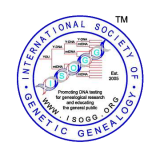X-chromosome testing
From ISOGG Wiki
X-chromosome testing, ranging from about 16,000 to over 28,000 SNPs (Single-nucleotide polymorphism), is included by default in popular autosomal DNA tests like those from 23andMe, AncestryDNA, Family Tree DNA's Family Finder test, Living DNA, MyHeritage, and others. See the ISOGG autosomal DNA testing comparison chart.
However, the ways in which information about the X-chromosome is reported differ from company to company. 23andMe count the amount of X-chromosome sharing in the evaluation of total centiMorgans shared between two individuals, while the other testing companies do not. Family Tree DNA provides a list of X-chromosome DNA matches but X-DNA matches are only reported if there is already an autosomal DNA match.
The other companies include X-DNA SNPs on their microarrays but do not provide any X-DNA reports or matches.
X-DNA can be independently analysed at third-party tools such as DNA Painter and GEDmatch. At GEDmatch you can also search for X-DNA matches.
Contents
X-chromosome inheritance
A number of family history programs such as Family Historian (version 7.0 onwards) include X-DNA charts generated from your family tree. WikiTree users can generate various DNA ancestors reports which include a list of all the ancestors who have contributed an X-chromosome and the average percentage shared. DNA Painter offers a number of family tree visualisation tools including X-DNA inheritance charts.
There are also a number of free charts available online:
- Ann Turner's text file of Ahnentafel numbers of ancestors who could contribute a segment on the X chromosome (file archived at the Internet Wayback Machine)
- Jim Turner's X-inheritance charts
- More X chromosome charts by Blaine Bettinger, The Genetic Genealogist', 12 January 2009.
- X-DNA charts from Debbie Parker Wayne - adapted from Blaine Bettinger's charts and made available with a Creative Commons Licence
- X-DNA charts from Sue Griffiths - adapted from Debbie Parker Wayne's charts with the addition of Ahnentafel numbers
- X-chromosome inheritance charts and a spreadsheet from Louise Coakley
Resources
- X-chromosome DNA, a video from the Sorenson Molecular Genealogy Foundation now hosted on the Learn Genetics website showing the inheritance of the X-chromosome.
- Katie and Julie's journey thru the X International Society of Genetic Genealogy, December 2009.
Further reading
- X-chromosome recombination by Jared Smith [undated article accessed 13 July 2016]
- Seeing the X-chromosome in a new light by Carl Zimmer, New York Times, 20 January 2014.
- X marks the spot for sperm production by Chris Palmer, The Scientist, 21 July 2013.
- The incredible expanding adventures of the X-chromosome by Christopher Badcock, Psychology Today, 6 September 2011.
- Facts and observations in relation to the X chromosome by David Faux, February 2009.
- Going Through a Phase: Haplotyping the Female X Chromosomes by Ann Turner, Satiable Curiosity, Journal of Genetic Genealogy 2008, Volume 4, Number 2.
- X chromosome: X inactivation by Janice Y Ahn and J T Lee. Nature Education 2008 1(1):24.
Scientific papers
- Arbiza L, Gottipati S, Siepel A, Alon Keinan A (2014). Contrasting X-Linked and Autosomal Diversity across 14 Human Populations. American Journal of Human Genetics 94(6): 827–44.
- Balaton B, Dixon-McDougall T, Peeters SB, Brown CJ (2018). The EXceptional Nature of the X Chromosome. Human Molecular Genetics 27(R2): 42–49.
- Buffalo V, Mount SM, Coop G (2016). A genealogical look at shared ancestry on the X chromosome. Genetics 204(1): 57–75. Published online 28 June 2016.
- Cotter DJ, Brotman SM, Wilson Sayres MAW (2016). Genetic Diversity on the Human X Chromosome Does Not Support a Strict Pseudoautosomal Boundary. Genetics 203(1): 485–92.
- Garrigan D, Mobasher Z, Severson T, Wilder JA, Hammer MF (2005). Evidence for archaic Asian ancestry on the human X chromosome. Molecular Biology and Evolution 22(2):189-92.
- Gottipati S, Arbiza L, Siepel A, Clark AG, and Keinan A (2011). Contrasting Human X-Linked and Autosomal Variation in Population-Scale Whole Genome Sequencing. Nature Genetics 43(8): 741–43.
- Schaffner SF (2004). The X chromosome in population genetics. Nature Reviews Genetics 5, 43-51 (January 2004).
- Mahtani MM, Willard HF (1998). Physical and Genetic Mapping of the Human X Chromosome Centromere: Repression of Recombination Genome Research 1998. 8: 100-110.
- Miga KH, Koren S, Rhie A, Vollger MR, Gershman A, Bzikadze A, et al. (2020). Telomere-to-Telomere Assembly of a Complete Human X Chromosome. Nature 585(7823): 79–84.
Blog articles
- Christmas S. Find family with X-DNA. Through the Trees, 22 February 2021.
- Woodbury P. The journey of DNA’s inheritance paths: X-DNA and autosomal DNA.Legacy Tree Genealogists, published online November 2020.
- Williams E. Matches on the X chromosome between male cousins. Counting Chromosomes, 21 January 2019.
- Bettinger B. An X-DNA case study. The Genetic Genealogist, 22 November 2017.
- Bettinger B. Preliminary results from the X-DNA inheritance project. The Genetic Genealogist, 12 February 2017.
- Woodbury P. How the X-chromosome solved a 100-year-old adoption mystery. Legacy Tree Genealogists, 10 August 2016.
- Buffalo V. A genealogical look at shared ancestry on the X-chromosome. The Blind Play of Genes, 30 June 2016.
- Coakley L. X-DNA's helpful inheritance patterns. Genie1 blog, 12 June 2015.
- Johnson K. What can the X chromosome tell us about the importance of small segments? Guest post on Kitty Cooper's blog, 19 December 2014.
- What does shared X DNA really mean? by Kitty Cooper, Kitty Cooper's blog, 6 January 2013.
- X marks the spot by Judy G Russell, The Legal Genealogist, 5 January 2013.
- Family Finder X-chromosome matching by Debbie Kennett, Cruwys News, 2 January 2014.
- X-chromosome matching at Family Tree DNA by Emily Aulicino, Genealem, 2 January 2014.
- Phasing the X-chromosome by Jim Owston, The Lineal Arboretum, 21 November 2012.
- X marks the spot by Roberta Estes, DNAeXplained, 27 September 2012.
- Understanding X-chromosome inheritance by Steve Handy. DNA Genealogical Experiences and Tutorials blog, 2 July 2012.
- X-Chromosome Testing vs mtDNA Testing by Ce Ce Moore, Your Genetic Genealogist, 4 July 2010.
- Unlocking the Secrets of the X by Blaine Bettinger, The Genetic Genealogist, 21 December 2008.
